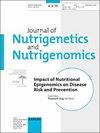The coming of age of nutrigenetics and nutrigenomics.
Q Agricultural and Biological Sciences
Journal of Nutrigenetics and Nutrigenomics
Pub Date : 2012-01-01
Epub Date: 2012-06-14
DOI:10.1159/000339375
引用次数: 16
Abstract
In recent years, human health has begun to face a new type of crisis. While the greatest risks of mortality in previous centuries were attributed to acute infectious disease, chronic metabolic disease is rapidly becoming a more significant concern, particularly in developed nations. According to the World Health Organization [1] , 65% of the world’s population now live in countries where obesity kills more people than diseases related to malnourishment. Medical advancements may have enabled us to outwit many of the pathogens that harmed us in the past, but now our most serious concerns are the diseases that arise from how we live. To address the rising prevalence of chronic diseases such as diabetes, obesity, heart disease, and cancer, it is imperative that we continue to develop our knowledge of the biological mechanisms that underlie these diseases and seek safer and more effective prevention and treatment. Needless to say, contributions from the fields of nutrigenetics and nutrigenomics are more critical now than ever before. Our understanding of genetics has progressed in leaps and bounds over the past decades, the apex of which was the completion of the Human Genome Project in 2004 [2] . Genetics play an integral role in every type of disease, whether the relationship is one of inheritance or the product of gene-environment interactions. This greater understanding of genetics has provided insight into the etiology of many diseases as well as the types of interventions that may be successful. We now understand that a variety of environmental stimuli trigger changes in gene expression, and that these changes underlie disease; for example, a decrease in global DNA methylation can upregulate genes involved in disease, such as cancer-promoting genes, thereby heightening the risk of developing cancer [3–5] . Clearly, nutrition and diet constitute a major source of environmental input, and there is reason to believe that increases in metabolic disease are associated with recent changes to the human diet and its impact on the genome. Published online: June 14, 2012营养遗传学和营养基因组学时代的到来。
本文章由计算机程序翻译,如有差异,请以英文原文为准。
求助全文
约1分钟内获得全文
求助全文
来源期刊

Journal of Nutrigenetics and Nutrigenomics
GENETICS & HEREDITY-NUTRITION & DIETETICS
CiteScore
1.86
自引率
0.00%
发文量
0
审稿时长
>12 weeks
期刊介绍:
The emerging field of nutrigenetics and nutrigenomics is rapidly gaining importance, and this new international journal has been established to meet the needs of the investigators for a high-quality platform for their research. Endorsed by the recently founded "International Society of Nutrigenetics/Nutrigenomics", the ‘Journal of Nutrigenetics and Nutrigenomics’ welcomes contributions not only investigating the role of genetic variation in response to diet and that of nutrients in the regulation of gene expression, but is also open for articles covering all aspects of gene-environment interactions in the determination of health and disease.
 求助内容:
求助内容: 应助结果提醒方式:
应助结果提醒方式:


